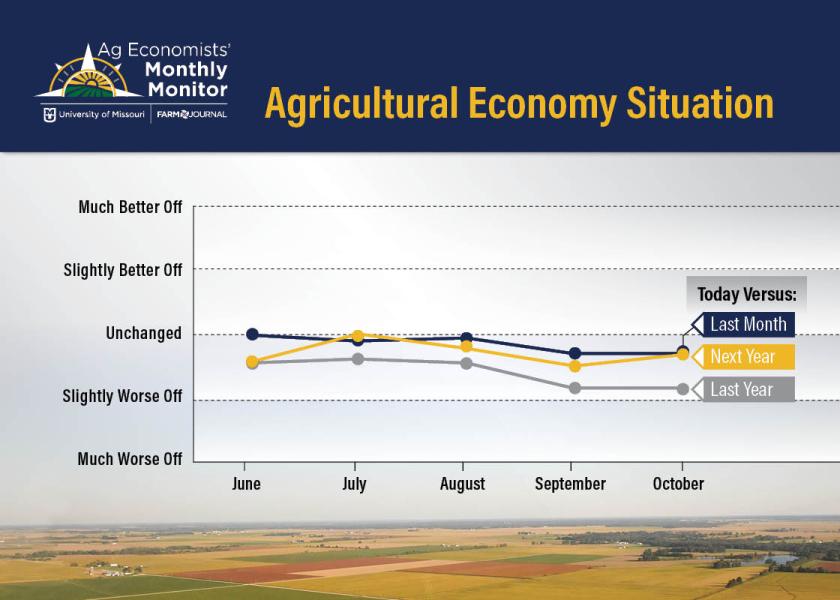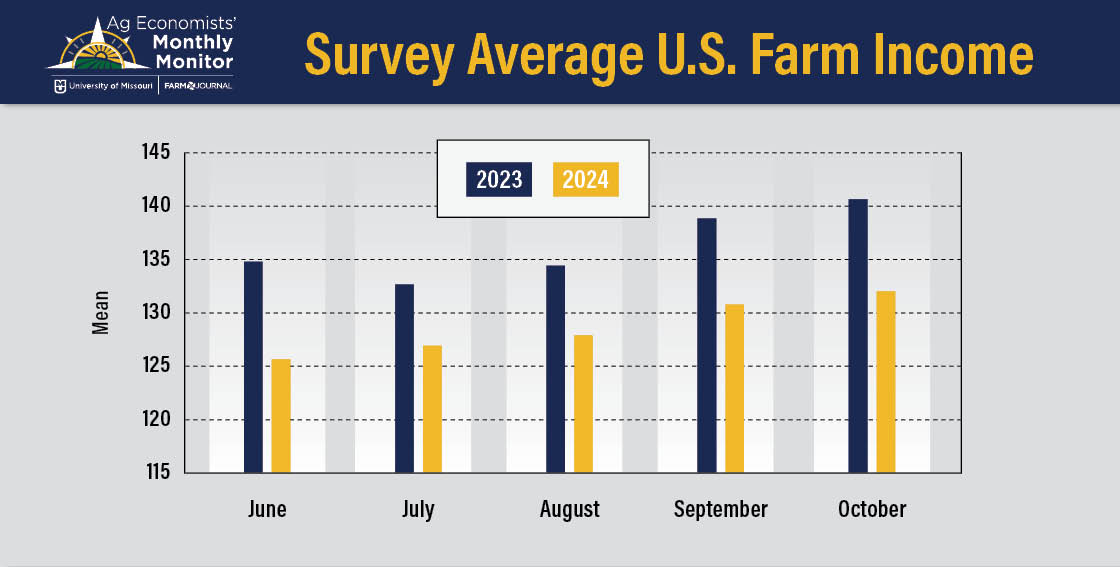The Ag Economy Is Healthy, And That's One Reason Economists Think It Could Be 2025 Before We See A New Farm Bill

Political dysfunction, a healthy ag economy, lack of urgency and the start of a presidential election year. These are all reasons leading agricultural economists to cast doubts on Congress’ ability to pass a new Farm Bill this year, as well as anticipate a strong possibility the legislation will face gridlock throughout all of 2024.
The Ag Economists’ Monthly Monitor is a survey of more than 60 ag economists across the country, conducted by the University of Missouri and Farm Journal. In the October survey, economists were a touch more optimistic about the ag economy picture for next year, while their thoughts around current economic conditions compared to last month remained unchanged.
“I'm not terribly surprised to see very much change in sort of the expectations on prices and incomes for the year,” says Jackson Takach, chief economist with Farmer Mac and one of the economists surveyed each month. “We have a lot of really new information coming out in the July, August, even September timeframe. But when you get to October, I think a lot of those expectations are starting to settle down. We're starting to really dial into what 23 looks like, and even starting to get a good picture of what 24 is going to start to look like."

Looking into this month’s results, Tackach says economists expect 2023 net farm income to top $140 billion, while forecasting 2024’s net farm income to reach just over $130 billion. That’s down from the record $183 billion USDA estimates for 2022. It’s not a disaster and more in line with what agriculture saw in 2021.
“It’s almost impossible to repeat the level of farm income that we had ’22,” Tackach says. “So of course, you're going to see some compression there. What I'm looking for is the revenue side. The input costs went up in 2022, parts of 2023. We've seen some relief in some of those input costs. So, now it's really about the revenue and what happens to commodity prices in 2024. Then, we're looking at the supply side. What kind of crop do we get out of Brazil? What kind of crop and yield do we get out of the U.S. next year? And I think that's going to be the deciding factor into how farm incomes go in 2024.”
2025 Farm Bill
With farm income still relatively healthy, and the current state of politics in Washington, the October Ag Economists’ Monthly Monitor shows there’s simply no urgency to get a Farm Bill written and passed, especially with 2024 being a political year.
The October survey asked economists what they thought the biggest hurdles are for getting a new farm bill written and passed. They said:
- Election year in 2024.
- Overall legislative dysfunction and turmoil, including leadership difficulties.
- Funding issues, including those at the overall government level.
- Competing issues and priorities, paired with limited time on the legislative calendar and no urgency around agriculture.

Of those surveyed, 50% think it will be 2025 before Congress passes a new farm bill. 20% think it could happen within the first half of 2024.
“Historically, when you get the alignment of a farm bill with that presidential election cycle, you tend to see people want to wait until after that cycle to see what changes - either colors over the White House or within the house of Congress itself,” Tackach says. “So, I think that's what the economists are reacting to. This is a presidential election year next year and we've got some things we need to address in terms of budgets and funding of the government just in general coming up in November.”
He says economists are taking note of the political realities of what happens in an election year, but also the ag economic picture.
“The ag economy is generally healthy. So, a lot of these changes that you might typically see in a farm bill year, maybe some of them can wait with an extension of the existing provisions and budget allocations,” he says.
Economists even disagree on timing of a farm bill extension. Of those surveyed, the majority think Congress will pass an extension, while two think it will fail to do so. Of those who think Congress will move on an extension, the majority think it’ll happen before the end of this year.
Top Two Factors That Could Shape Agriculture Over the Next 12 Months
If Congress is unable to pass a new farm bill before 2025, economists worry farmers could face crop prices below break-even. When asked what they think are the two most important factors that could shape agriculture over the next 12 months, rising costs and declining crop prices were some of the top concerns.
- “Crop margins are considerably tighter than they were last year. In addition to relatively high breakeven prices, crop prices are much lower this fall,” responded one economist.
- “Today: weaker commodity prices for crops, high interest rates; 12 month: I expect lower input costs,” said another economist.
- “Today- commodity prices and working capital; 12 Months- interest rates and production,” an economist said in the October survey.
- “Impact from escalating interest rates. Disappointing export sales,” was another response.
- “The outlook for commodity prices and for input costs. In 2023, commodity prices have declined, while input costs remain high. In 2024, both may be lower than in 2023,” responded one economist.
Takach points out balance sheets are healthy today, but there are rising concerns about the cost side of them.
“Balance sheets are incredibly strong. We got a couple of years of really strong incomes and farmers and ranchers socked away a lot of that cash. I've rebuilt our working capital after several years of maybe tighter margins in 2018/2019. So, replenishment of that working capital was a welcome sign for ag lenders. But of course, for those farm families in ‘23, you do see those higher costs: higher cost of land, higher cost of interest, higher costs of labor. All those sorts of things start to eat into the cost of production,” he says.
Looking Ahead to the Next 6 Months
Economists were also asked what factors will impact crop and livestock prices over the next 6 months.
For crops, they said:
- South American production and weather favorability.
- Export competition from Russia and Brazil.
- Global factors including economic health, geopolitical risks, dollar strength and demand impacts on export volumes.
- Domestic demand and final size of the 2023 crop.
For livestock, they said:
- Tight cattle/beef supplies, sow herd liquidation.
- Cost of production, including feed costs and interest rates.
- Confidence in domestic consumer demand, export opportunities.
Related News:
The One Factor That Could Make Or Break the Farm Economy Over the Next 12 Months
Is A Recession Imminent? Here Are The Red Flags Ag Economists Are Now Watching







